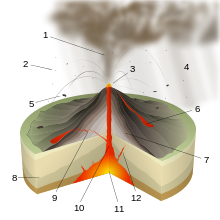| Kiyoo Mogi | |
|---|---|
| Born | 1929 Yamagata Prefecture |
| Died | 6 June 2021 |
| Known for | Mogi doughnut hypothesis; Mogi model; Former chair of the Japanese Coordinating Committee for Earthquake Prediction |
| Scientific career | |
| Fields | Seismology; Seismotectonics |
| Institutions | Director, Earthquake Research Institute, University of Tokyo; Professor, Nihon University |
Kiyoo Mogi (茂木 清夫, Mogi Kiyoo, 1929 in Yamagata Prefecture, Japan–6 June 2021) was a prominent seismologist. He was regarded as Japan's foremost authority on earthquake prediction and was a chair of the Japanese Coordinating Committee for Earthquake Prediction (CCEP). Mogi was also a director of the University of Tokyo's Earthquake Research Institute, a professor at Nihon University and a professor emeritus at Tokyo University. Due to the seismic activity in Japan, Mogi also took an interest in the safety of nuclear power in Japan.
In 1969, Mogi predicted that there was a possibility of a shallow magnitude 8.0 earthquake in the Tōkai region of Japan, an area that has experienced a number of previous large earthquakes. Following the passing of the Large-Scale Earthquake Countermeasure Act, in 1978, Mogi was appointed to the newly created Earthquake Assessment Committee (EAC) for the expected Tokai earthquake, charged with warning the government if the quake was imminent. He went on to chair the ECA from 1991 until he resigned from the post in 1996 after failing to persuade the government of the need to take uncertainty into account when issuing warnings.
Nuclear power
Following damage at the Kashiwazaki-Kariwa Nuclear Power Plant due to the 2007 Chūetsu offshore earthquake, Mogi called for the immediate closure of the Hamaoka Nuclear Power Plant, which was built close to the centre of the expected Tōkai earthquake despite his 1969 prediction. Previously, in 2004, he had stated that the issue 'is a critical problem which can bring a catastrophe to Japan through a man-made disaster'.
Mogi doughnut hypothesis
In 1969, Mogi proposed a hypothesis for earthquake prediction, now known as the 'Mogi doughnut hypothesis', that major earthquakes tend to occur in an unusually seismically calm area surrounded by a ring of unusually high seismic activity. The Mogi doughnut is one of several pattern hypotheses that have been proposed.
Mogi model

In 1958, Mogi was responsible for a major advance in understanding the dynamics of volcanos. After studying data from several sources, he concluded that a mathematical solution developed by Yamakawa in 1955 could be used in the modelling of the deformation of a volcano caused by pressure changes in its magma chamber. The 'Mogi model' (also known as the 'Mogi-Yamakawa model') subsequently became the first commonly used quantitative method in volcanology, and is still widely used today.
Bibliography
- Experimental Rock Mechanics (2006)
- Earthquake Prediction (1985)
See also
- Hamaoka Nuclear Power Plant
- Fukushima I nuclear accidents
- Katsuhiko Ishibashi
- Nuclear power in Japan
- Geology of Japan
- Pacific Ring of Fire
References
- 茂木清夫氏死去(東京大名誉教授・地球物理学) (in Japanese)
- ^ Nuclear crisis in Japan as scientists reveal quake threat to power plants The Times, published 2007-07-19, accessed 2011-03-18
- ^ Quake shuts world's largest nuclear plant Nature, vol 448, 392-393, doi:10.1038/448392a, published 2007-07-25, accessed 2011-03-18
- Japan Questions Its Costly Program to Predict Earthquakes New York Times, published 1998-01-13, accessed 2011-03-18
- ^ Two grave issues concerning the expected Tokai Earthquake Kiyoo Mogi, Earth Planets Space, Vol. 56 (No. 8), pp. li-lxvi, published 2004, accessed 2011-03-11
- Japan Holds Firm to Shaky Science Science, Vol. 264 no. 5166 pp. 1656-1658, doi:10.1126/science.264.5166.1656, published 1994-06-17, accessed 2011-03-18
- The Mogi Donut Archived 2010-07-02 at the Wayback Machine Alaska Science Forum, published July 9, 1979-07-07, accessed 2011-03-18
- Evidence for Mogi doughnut behavior in seismicity preceding small earthquakes in southern California Peter M. Shearer and Guoqing Lin, Journal of Geophysical Research, vol. 114, B01318, doi:10.1029/2008JB005982, published 2009-01-30, accessed 2011-03-18
- Mogi Donut - There's a hole in this possible earthquake pattern Los Angeles Times, published 2010-07-18, accessed 2011-03-18
- Pattern Dynamics and Forecast Methods in Seismically Active Regions Archived 2017-08-12 at the Wayback Machine K.F. Tiampo, J.B. Rundle, S. McGinnis, W. Klein; CIRES, University of Colorado; accessed 2011-03-24
- ^ Earthquake and Volcano Deformation, P Segall, Princeton University Press; ISBN 978-0-691-13302-7; published 2010
- On the strain produced in a semi-infinite elastic solid by an interior source of stress N Yamakawa, Journal of the Seismological Society of Japan, (II), 8, 84-98, published 1955
- Relations between the eruptions of various volcanoes and the deformations of the ground surfaces around them. K Mogi. Bulletin of the Earthquake Research Institute, University of Tokyo, vol 36, 99-134, published 1958
- ^ Analytical volcano deformation source models M Lisowski, D Dzurisin; Volcano Deformation; publisher Springer Berlin Heidelberg; ISBN 978-3-540-49302-0; doi:10.1007/978-3-540-49302-0_8; published 2006
- On the Dynamics of Rhyolite Dome Emplacement: Densities and Deformation Fields Th Agustsdottir, Master's thesis; Faculty of Sciences, University of Iceland; published 2009, accessed 2011-03-25
- Calculations of Elliptical Pressure Source Models by FEM Archived 2012-03-15 at the Wayback Machine T Sakai, T Yamamoto, K Fukui, K Fujiwara, A Takagi, accessed 2011-03-25
| 2011 Tōhoku earthquake and tsunami | |||||||||
|---|---|---|---|---|---|---|---|---|---|
| Nuclear accidents |
| ||||||||
| Foreshocks, Aftershocks |
| ||||||||
| Relief and Recovery |
| ||||||||
| Pop culture | |||||||||
| Other | |||||||||